Abstract
The demand for energy grows along with the number of studies in the field of alternative energy. Clean energy has been the goal of numerous studies and it has been encouraged, seen by the gradual migration from conventional to hybrid or purely electric vehicles. Although clean energy is desirable, we continue to rely on traditional fuel. Thus, this work aims to improve the efficiency and minimize the polluting effects of the fuels in internal combustion engines. Using the combustion mode of reactivity-controlled compression ignition, in which two different fluids, with distinct auto-ignition characteristics, are injected into the combustion chamber, at different times, aiming to burn the fuel at a lower power of auto-ignition. Parameters such as the amount of fuel and start of injections points (SOIs) have substantial influence on the overall process. Performance, emissions, combustion noise and others characteristics are mainly influenced by the ignition delay. The ignition delay in a diesel engine is defined as the interval of time between the start of fuel injection and the combustion. Therefore, with the SOI of the fuel with lower enthalpy of vaporization and the start of combustion, the ignition delay can be inferred. The results show the influence of different parameters, such as compression ratio, start of fuel injections, injection strategies of two different fuels, in this case, hydrous ethanol and diesel, on the combustion process. The results are presented for compression ratios of 16:1 and 20:1.













Similar content being viewed by others
References
Ometto A (2005) Life cycle assessment of hydrous ethylic alcohol fuel by EDIP, exergy and emergy methods. Ph.D thesis—Escola de Engenharia de So Carlos, Universidade de São Paulo
Goldenstein M, Azevedo R (2006) Alternative fuels and innovation in automotive sector: the end of “Age of Oil”? BNDES 23:235–266
Schaefer A, Hardenberg H (1981) Ignition improvers for ethanol fuels. SAE Technical Paper 810249. doi:10.4271/810249
Dickerson M (2005, June 17) Brazil’s ethanol effort helping lead to oil self- sufficiency. The Seattle Times
Sánchez F, Braga C, Braga L, Braga S. et al. (2013) Ethanol-powered combustion experimental study in a rapid compression machine. SAE Technical Paper 2013-36-0313. doi:10.4271/2013-36-0313
Yilmaz N, Donaldson A, Johns A (2005) Some perspectives on alcohol utilization in a compression ignition engine. SAE Technical Paper 2005-01-3135. doi:10.4271/2005-01-3135
Simonsen H, Chomiak J (1995) Testing and evaluation of ignition improvers for ethanol in a DI diesel engine. SAE Technical Paper 952512. doi:10.4271/952512
Valdez J (2014) Reactivity controlled compression ignition of diesel fuel and ethanol in rapid compression machine. Ph.D thesis, Departamento de Engenharia Mecânica, Pontifical Catholic University of Rio de Janeiro, Rio de Janeiro
Egúsquiza CJC (2011) Experimental investigation of a diesel cycle engine operating on dual-fuel mode: diesel/ethanol and diesel/gas. Ph.D thesis, Departamento de Engenharia Mecânica, Pontifical Catholic University of Rio de Janeiro, Rio de Janeiro
Kokjohn S, Hanson R, Splitter D, Kaddatz J et al (2011) Fuel reactivity controlled compression ignition (rcci) combustion in light and heavy - duty engines. SAE Int J Engines 4(1):360–374. doi:10.4271/2011-01-0357
Splitter D, Reitz R, Hanson R (2010) High efficiency, low emissions RCCI combustion by use of a fuel additive. SAE Int J Fuels Lubr 3(2):742–756. doi:10.4271/2010-01-2167
Curran S, Hanson R, Barone T, Storey J et al. (2012) Performance of advanced combustion modes with alternative fuels: reactivity controlled compression ignition case study. Energy & Transportation Science Division Oak Ridge National Laboratory, CBES Forum
Jayaraman S (2012) Performance optimization of a diesel engine for dual—fuel combustion. M.Sc. thesis, The Graduate School College of Engineering, The Pennsylvania State University, State College
Heywood J (1988) Internal combustion engine fundamentals, 1st edn. Mc Graw- Hill Book Company, New York
Zou H, Wang L, Liu S, Li Y (2008) Ignition delay of dual fuel engine operating with methanol ignited by pilot diesel. Front Energy 2(3):285–290. doi:10.1007/s11708-008-0060z
Reddy P, Krishna D, Mallan K, Ganesan V (1993) Evaluation of combustion parameters in direct injection diesel engines—an easy and reliable method. SAE Technical Paper 930605. doi:10.4271/930605
Shahabuddin M et al (2013) Ignition delay, combustion and emission characteristics of diesel engine fueled with biodiesel. Renew Sustain Energy Rev 21:623–632
Da Silva E, Trres R (2013) Thermophysical properties of diesel/biodiesel blends. In: 22nd international congress of mechanical engineering (COBEM 2013), São Paulo, pp 6577–6584
Villela A, Machado G (2012) Multifuel engine performance, emissions and combustion using anhydrous and hydrous ethanol. SAE Technical Paper 2012-36-0475. doi:10.4271/2012-36-0475
Turkan A, Canakci M (2011) Combustion characteristics of an indirect injection (IDI) diesel engine fueled with ethanol/diesel and methanol/diesel blends at different injection timings. World Renew Energy Cong 1:3565–3572
Bodisco T, Brown R (2013) Inter-cycle variability of in-cylinder pressure parameters in an ethanol fumigated common rail diesel engine. Energy 52:55–65. doi:10.1016/j.energy.2012.12.032
Author information
Authors and Affiliations
Corresponding author
Additional information
Technical Editor: Francisco Ricardo Cunha.
Rights and permissions
About this article
Cite this article
Loaiza, J.C.V., Sánchez, F.Z. & Braga, S.L. Combustion study of reactivity-controlled compression ignition (RCCI) for the mixture of diesel fuel and ethanol in a rapid compression machine. J Braz. Soc. Mech. Sci. Eng. 38, 1073–1085 (2016). https://doi.org/10.1007/s40430-015-0400-y
Received:
Accepted:
Published:
Issue Date:
DOI: https://doi.org/10.1007/s40430-015-0400-y















